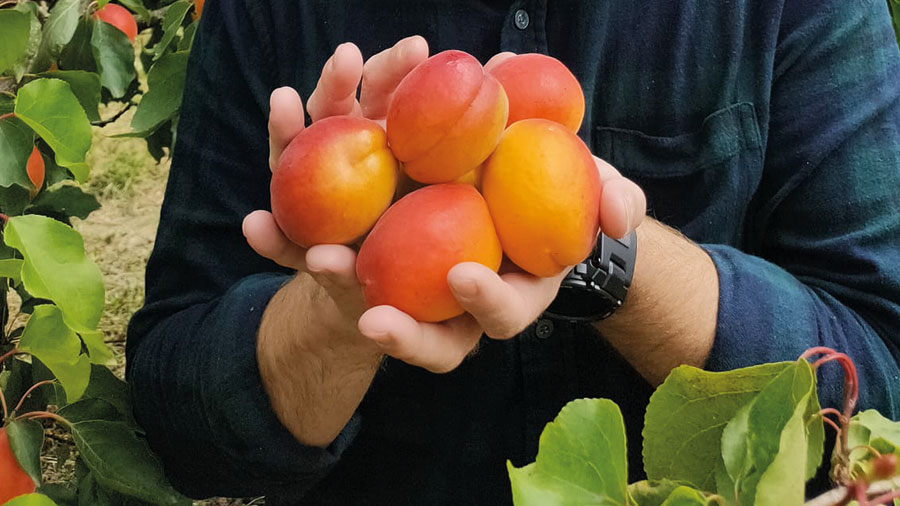How a British grower is producing top-quality apricots
 © DPS
© DPS David Moore, director of agriculture for Direct Produce Supplies (DPS) is on a mission to create a British-grown fruit that is attractive to the eye and excites the UK palate.
The perfect apricot has an orange-red blush, tastes sweet, is about 55mm diameter and will be a firm eat, he says.
“Currently, imported apricot fruit that is on the shelf between June and September can sometimes be pale in colour, quite acidic to the taste and there are varieties that are hairy, which discourages some consumers,” he says.
“The eating experience is critical – but customers buy with their eyes, too.”
See also: How mixed farm award winners diversified into apple market
David has concluded that even the best growers in countries such as Spain struggle to supply first-class products, because it is simply too hot at this time in their regions.
Following extensive research, trials and partnerships, the DPS farm in Kent is now growing 14ha of apricots, including the varieties Pricia, Medflo, Farlis and Milord.
This has been the first year a commercial crop has been harvested from the trees that were planted in 2018 on south-facing ground, with a free-draining brick earth over greensand soil, says David.
How to grow apricots
“We were due to harvest the crop last year, but we had 18 consecutive frosts in April 2021 so that basically killed off the flowers,” says David.
“While the warmer weather we’re getting generally has opened the door on growing a crop like this, ironically the cooler British night-time temperature is also important.
“This produces very high-quality apricots as the fruit grows more slowly, resulting in a more intense and sweeter taste, plus a stronger, richer colour.”
The ideal tree, he explains, is 2x2m,with the middle pruned out to create a goblet shape, allowing light into the middle of – and around – the tree.
They’re spaced 2m apart down the row, about 4m apart between the rows and planted in a diamond shape so the trees don’t shade each other.
Keeping the trees at a height of 2m means pruning, husbandry and harvesting can be done from the ground, dispensing with the need for steps, boxes and access platforms.
“For the first two years, you don’t really want to grow fruit as you’re trying to establish the tree’s frame – basically, you’re trying to build something for the next 15 years of fruiting, so you don’t want to stress the tree.
“The reason we’ve been able to set a crop this year is we’ve invested £40,000/ha in frost covers – a woven material we put over the trees to protect them from extreme cold and wind.
“This breathable mesh allows us to insulate the crop and build a thermal mass of air around the trees. When those cold nights occur, we’ve got a 3C buffer between the inside and outside.”
With revenue of about £24,000/ha, it’s a high return, but also a high investment and a high input enterprise, stresses David.
“It’s certainly not one to go into on a whim – we were fortunate to have a customer, Tesco, saying: “We have a gap in the market – can you fill it?”
“While it might be in the DNA of farmers and horticulturalists to grow crops and feed the nation, it’s vital to make sure you are consumer-driven and only grow what the market requires.”
From a handful of growers, including the well-known Kent fruit producer Tom Hulme, there could be 250t of apricots grown in the UK this year, with the first English apricots on the shelf in July – but it could develop into a much larger market, believes David.
“Consumer research tells us that when people have great-tasting fruit, whether it’s an apple, strawberry or a plum, they want more of it. It’s a long process though. It can take 10 years for a market to evolve.”
Meanwhile, DPS – which already sells imported red-skin, red-flesh plums – is also attempting to grow these in the UK, and plans to pick its first commercial crop this year.
Sunlight
The apricot industry is always likely to be limited to southern England, he says. “Ultimately, it’s limited by the amount of intensity of sunlight.
“We will grow 12t/ha of apricot in Kent, but on a farm I’m involved with in South Africa, we can get 40t/ha because it has so much more natural sunlight intensity.
“Whether you’re an arable farmer, horticulturalist, top-fruit grower or stone-fruit grower, the volatility of the weather is the biggest risk you have – and dealing with that is the main challenge you face. Hence the mesh covers – we simply can’t afford to invest £30,000/ha in trees and irrigation systems for wind, frost or hail to knock it out in one night.”
While it wouldn’t be an easy step to go from growing combinable crops to apricots, if you’re a horticulturalist your knowledge and skill set would stand you in good stead to diversify into fruit production, says David.
Specialist fruit growers need to be fastidious, though, he acknowledges.
“I’m constantly looking at temperature, moisture and humidity. At 4pm on a Sunday afternoon, you need to know that the irrigation is working and what’s happening to the quality of your fruit. The trees are like your children.
“Growers have a lot of energy, determination and resilience. If you need to go out at 2am for five nights on the trot because the frost alarm has gone off, then that’s what you’ve got to do.
“But growing a fantastic orchard of apricots is the same as growing a fabulous field of wheat – there’s no better feeling in the world than harvesting it.”
